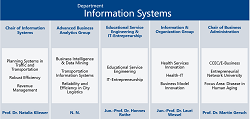Incentives and disincentives for sharing frailty-related information in perioperative care based on an integrated IT approach
In Germany, approximately 16 million patients undergo surgical procedures per year, half of which are performed in patients over the age of 65. These patients are especially prone to frailty – defined as a clinically recognizable state of increased vulnerability resulting from aging-associated decline in reserve and function across multiple physiologic systems. Frailtyhas been recognized as underestimated area of health care, affecting both the individual patient as well as society from a greater public health perspective. Elderly patients undergoing surgery are prone to develop frailty-related complications that may go far beyond the index hospitalization (e.g. cognitive impairment following postoperative delirium). However, aging-relevant information are currently not fully integrated into hospitals’ perioperative processes.

For the management of patients’ anesthesia including adequate monitoring after the operation, anesthetists rely on comprehensive access on data that reflect the patient’s status and individual risk. Even if these data are in parts electronically available, they are mostly scattered among multiple IT structures that are not semantically connected. Previous research from an information systems viewpoint shows that when information exchange with other internal and external units is fostered, a standardization dilemma arises where local incentives make actors reluctant to adopt a globally-optimal solution. This DynAge-supported project combines these two streams of research (i.e. frailty and economics of information systems) in a novel way by asking: (1.) How can information technology support the compilation and processing of patient-/surgery related data for frailty-related risk identification and stratification, and (2.) with whom are and should frailty-related information be exchanged within the patient treatment process and what are the incentives and disincentives of these actors?
To explore these aspects, we focus on perioperative care provided by the CharitéCenter for Anesthesiology and Intensive Care Medicine. In a first step, we will conduct interviews with medical domain experts. Secondly, we will map the topological information on how frailty-associated patients are transferred between various hospital structures during their hospitalization. In a third step, we aim to determine the inertia costs that arise from the adaptations of local procedures, a switch or adaptation of existing IT systems, replacement of IT infrastructure). In a forth step, we want to determine integration benefits (e.g., time and cost savings, better information quality). Finally, we will visualize the collaboration network and perform first what-if analyses regarding incentive readjustments as well as present, discuss, and validate the preliminary scenarios with domain experts.

By focusing on frailty-related information exchanges and drawing on an economic computational modeling approach, the project directly addresses aging-related processes by mapping the topology of frailty-related information exchanges and by illustrating the incentive structures for different stakeholders within that process. This can firstly help to increase awareness of the importance of such data exchanges and secondly inform efforts to transform treatment processes such that they go beyond informational silos and take into account the potentials for frail patients arising from integrated information systems.
|
Project duration: |
One year (07/2016 – 06/2017) |
|
Contact persons: |
|
|
Project funding: |
Focus Area “DynAge“ – Excellence Initiative II from Freie Universität Berlin and Charité University Medicine Berlin |
|
Project partner: |
PD Dr Felix Balzer (Charité Berlin) Prof. Dr. Claudia Spies (Charité Berlin) Prof. Dr. Ursula Müller-Werdan (Charité Berlin) |





